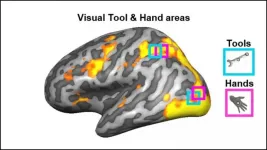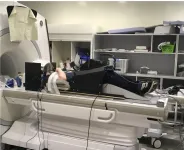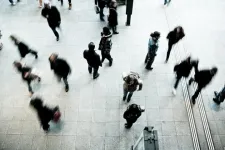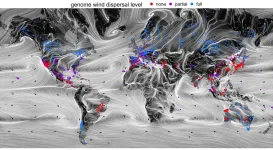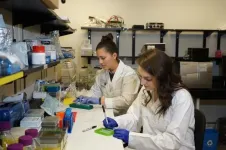(Press-News.org) ATLANTA--Gestures--such as pointing or waving--go hand in hand with a child's first words, and twins lag behind single children in producing and using those gestures, two studies from Georgia State University psychology researchers show.
Twins produce fewer gestures and gesture to fewer objects than other children, said principal researcher Seyda Ozcaliskan, an associate professor in the Department of Psychology. Language use also lags for twins, and language--but not gesture--is also affected by sex, with girls performing better than boys, Ozcaliskan said.
"The implications are fascinating," said Ozcaliskan. "It shows that gesture and speech go hand in hand in early development in twins. When one is lagging behind so does the other."
The research found that a lag in gesture can reliably predict a lag in speech. At the same time, lots of gesturing suggests speech is on the way. Parents can help speed their child's acquisition of language by naming the objects they gesture to.
The lag in gesture among twins may be due to lower parental input, Ozcaliskan said, for parents of single children used a greater amount and diversity of gestures than parents of twins. It's likely, Ozcaliskan said, that parents caring for twins engage in shorter conversations with their children, including gesturing less, because their attention is divided and their labor is doubled.
The studies were conducted by Ozcaliskan and her psychology doctoral students Ebru Pinar and Sumeyra Ozturk, along with her collaborator Dr. Nihan Ketrez in Istanbul. The paper Parental Speech and Gesture Input to Girls Versus Boys in Singletons and Twins was published in the Journal of Nonverbal Behavior and Effect of Sex and Dyad Composition on Speech and Gesture Development of Singleton and Twin Children was published in the Journal of Child Language. The two studies analyzed video data from Turkish families and included three groups of fraternal twins--males, females and mixed sex twins, as well as two groups of single boys and girls, along with their parents.
Ozcaliskan said she had grown curious about gesture because it had not yet been studied among twins, while language acquisition has been thoroughly researched.
"We've known for a long time that children's early vocabulary shows sex differences," said Ozcaliskan, "with boys having smaller vocabularies than girls their age."
Girls age 2-3 also produce longer, more complex sentences than boys. Twins are initially at a disadvantage where language is concerned, using fewer words than their singleton peers and forming complete sentences later than singletons. Boys lag the most, with girl-girl twins developing larger vocabularies and more complex sentences than boy-boy twins of comparable age.
Most of the time, these lags are within the normal range of differences, and nothing to worry about. Almost all children will catch up to each other by around age three and a half.
But what about gesture?
"There was close to nothing in research on gesturing among twins in any language," Ozcaliskan said.
Infants start using pointing around 10 months, a few months before they produce their first words. In other words, they point at a dog a few months before they actually say the word "dog." Gesture helps them convey what they can't yet communicate in speech and paves the way for children's early words.
Though the lag in gesture and language among twins may be mostly due to reduced parental input, Ozcaliskan said twins sometimes develop their own systems of communication, even their own "twin language," which has been shown to delay language acquisition. "Perhaps it also delays the use of gestures," she said.
On most occasions, a lag in gesture may mean a lag in the next linguistic milestone.
"However, in the event that you see the lag in gesture go on for a long time, it may be a marker of a potential developmental or language delay," said Ozcaliskan. On the other hand, if a child doesn't talk much at an early age, but frequently uses gesture, a parent can be reassured that "language is on its way," she said.
The more a parent engages with a child, using gesture and speech, the better the child's acquisition of both. Gesture and speech together form a closely integrated system in a child's development, and a child's first gestures often precede their first attempts at speech.
For parents who are intrigued by these connections, Ozcaliskan suggested naming objects when children point to them, as in: Yes, that's a bottle, do you want your bottle? Naming helps children learn new words earlier. Parents can also make a point of gesturing to objects themselves when naming.
"Gesture is a very powerful tool," Ozcaliskan said. "Pay attention to your child's gestures, and then provide verbal descriptions to help their language development."
INFORMATION:
MISSOULA - University of Montana Professor Mark Hebblewhite has joined an international team of 92 scientists and conservationists to create the first-ever global atlas of ungulate (hoofed mammal) migrations.
Working in partnership with the Convention on the Conservation of Migratory Species of Wild Animals, a U.N. treaty, the Global Initiative on Ungulate Migration (GIUM) launches May 7 with the publication of a commentary in Science titled " END ...
Visual brain areas involved in processing hands also encode information about the correct way to hold tools, according to new research published in JNeurosci.
Each part of the brain's visual system activates in response to a certain type of item -- whether it's faces, tools, objects, or hands. Scientists assumed the brain segregates visual information in this way to optimize motor actions with tools. Yet most studies investigating the brain mechanisms for tool grasping used images of tools or hands, and no actual hand movements were performed.
Knights et al. used fMRI to measure the brain activity of participants as they grasped 3D-printed kitchen tools (spoon, knife, and pizza cutter) and similar-sized non-tools. ...
Researchers at the University of East Anglia have made an astonishing discovery about how our brains control our hands.
They used MRI data to study which parts of the brain are used when we handle tools, such as a knives.
They read out the signal from certain brain regions and tried to distinguish when participants handled tools appropriately for use.
Humans have used tools for millions of years, but this research is the first to show that actions such grasping a knife by its handle for cutting are represented by brain areas that also represent images of human hands, our primary 'tool' for interacting with the world.
The research ...
Imaging technology has come a long way since the beginning of photography in the mid-19th century. Now, many state-of-the-art cameras for demanding applications rely on mechanisms that are considerably different from those in consumer-oriented devices. One of these cameras employs what is known as "single-photon imaging," which can produce vastly superior results in dark conditions and fast dynamic scenes. But how does single-photon imaging differ from conventional imaging?
When taking a picture with a regular CMOS camera, like the ones on smartphones, ...
Peptides " short strings of amino acids" play a vital role in health and industry with a huge range of medical uses including in antibiotics, anti-inflammatory and anti-cancer drugs. They are also used in the cosmetics industry and for enhancing athletic performance. Altering the structure of natural peptides to produce improved compounds is therefore of great interest to scientists and industry. But how the machineries that produce these peptides work still isn't clearly understood.
Associate Professor Max Cryle from Monash University's Biomedicine Discovery Institute (BDI) has revealed a key aspect of peptide machinery in a paper published in Nature Communications today that provides a key to the "Holy Grail" of re-engineering peptides..
The findings will advance his lab's work into ...
A new study from the Harvard GenderSci Lab in the journal Human Fertility, "The Future of Sperm: A Biovariability Framework for Understanding Global Sperm Count Trends" questions the panic over apparent trends of declining human sperm count.
Recent studies have claimed that sperm counts among men globally, and especially from "Western" countries, are in decline, leading to apocalyptic claims about the possible extinction of the human species.
But the Harvard paper, by Marion Boulicault, Sarah S. Richardson, and colleagues, reanalyzes claims of precipitous human sperm declines, re-evaluating evidence presented in the widely-cited 2017 meta-analysis by Hagai Levine, Shanna ...
Berkeley -- Forests' ability to survive and adapt to the disruptions wrought by climate change may depend, in part, on the eddies and swirls of global wind currents, suggests a new study by researchers at the University of California, Berkeley.
Unlike animals, the trees that make up our planet's forests can't uproot and find new terrain if conditions get tough. Instead, many trees produce seeds and pollen that are designed to be carried away by the wind, an adaptation that helps them colonize new territories and maximize how far they can spread their genes.
The ...
New research demonstrates that African and Asian leopards are more genetically differentiated from one another than polar bears and brown bears. Indeed, leopards are so different that they ought to be treated as two separate species, according to a team of researchers, among them, scientists from the University of Copenhagen. This new knowledge has important implications for better conserving this big and beautiful, yet widely endangered cat.
No one has any doubts about polar bears and brown bears being distinct species. Leopards, on the other hand, are considered one and the same, a single species, whether of African or Asian ...
AURORA, Colo. (May 10, 2021) - Looking to safely block a gene linked to factors known to cause heart disease, scientists at the University of Colorado Anschutz Medical Campus may have found a new tool - light.
The study, published Monday in the journal Trends in Molecular Medicine, may solve a medical dilemma that has baffled scientists for years.
The gene, ANGPTL4, regulates fatty lipids in plasma. Scientists have found that people with lower levels of it also have reduced triglycerides and lipids, meaning less risk for cardiovascular disease.
But blocking the gene using antibodies triggered dangerous inflammation in mice. Complicating things further, the gene can also be beneficial in reducing the risk of myocardial ...
Hamilton, ON (May 10, 2021) - It is well known that each person's gut bacteria is vital for digestion and overall health, but when does that gut microbiome start?
New research led by scientists from McMaster University and Charité - Universitätsmedizin Berlin in Germany has found it happens during and after birth, and not before.
McMaster researchers Deborah Sloboda and Katherine Kennedy examined prenatal stool (meconium) samples collected from 20 babies during breech Cesarean delivery.
"The key takeaway from our study is we are not colonized before birth. Rather, our relationship with our gut bacteria emerges ...

